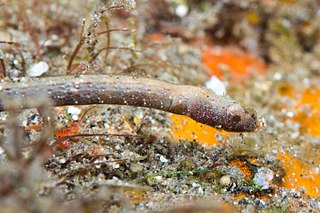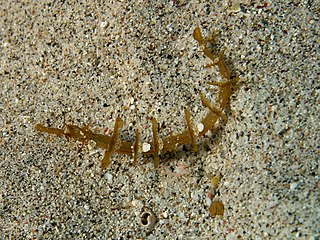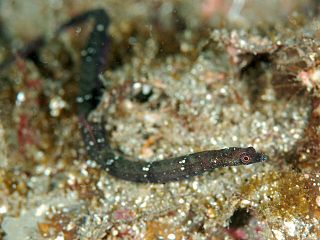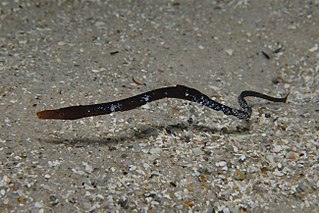
Schultz's pipefish, Corythoichthys schultzi, is a pipefish of the family Syngnathidae.
Doryrhamphus janssi, commonly known as the Janss' pipefish , is a species of pipefish belonging to the family Syngnathidae.

Corythoichthys intestinalis, known commonly as the scribbled pipefish, is a species of marine fish in the family Syngnathidae. Other common names used include banded pipefish, Australian banded pipefish, Australian messmate pipefish and messmate pipefish.

Doryrhamphus excisus is a species of flagtail pipefish from the genus Doryrhamphus. Its common names include blue-striped pipefish and blue-and-orange cleaner pipefish. The fish is found throughout much of the Indo-Pacific and tropical East Pacific.

Halicampus dunckeri or also commonly known as the Duncker's pipefish or ridgenose pipefish is a species of fish in the family Syngnathidae.

Halicampus macrorhynchus or also commonly known as the ornate pipefish , whiskered pipefish or winged pipefish is a species of fish in the family Syngnathidae.
Hippichthys cyanospilos, commonly known as the blue-spotted pipefish or bluespeckled pipefish, is a marine fish belonging to the family Syngnathidae, native from the Indo-Pacific area.

Choeroichthys brachysoma is a species of marine fish of the family Syngnathidae.
Corythoichthys paxtoni, commonly known as Paxton's pipefish, is a species of marine fish of the family Syngnathidae. It is endemic to the Coral Sea, being found in the Great Barrier Reef, the Chesterfield Islands, and New Caledonia. It inhabits coral reefs and rubble lagoons to depths of 18 metres (59 ft), where it can grow to lengths of 13 centimetres (5.1 in). This species mates monogamously and is ovoviviparous, with males carrying eggs until giving birth to live young.

Booth's pipefish is a species of marine fish of the family Syngnathidae. It is found in the Western Indian Ocean, in South Africa and the Comoro Islands, and in the Western Pacific, from South Korea and Japan to the Great Barrier Reef and Tonga. It lives in rocks and coral reefs to depths of 30 metres (98 ft), where it can grow to lengths of 17.5 centimetres (6.9 in). This species is ovoviviparous, with males carrying eggs and giving birth to live young.
Gray's pipefish, also known as the mud pipefish or spiny pipefish is a species of marine fish of the family Syngnathidae. It is found in the Indo-Pacific in the Gulf of Aden, Sri Lanka, and from the Gulf of Thailand to Japan, the Marshall Islands, and the Great Barrier Reef. It lives to depth of 100 metres (330 ft), and planktonic juveniles have been found above depths of 3,000 metres (1.9 mi). It occurs in muddy habitats, in estuaries, and on coral reefs, where it likely feeds on small crustaceans. It can grow to lengths of 20 centimetres (7.9 in). This species is ovoviviparous, with males carrying eggs in a brood pouch before giving birth to live young.
The spinysnout pipefish is a species of marine pipefish of the family Syngnathidae. It is found in the Indo-Pacific, from Sri Lanka to Samoa, and from Japan and the Marshall Islands to central Australia. It lives in rocky and coral reefs, rubble, lagoons and intertidal zones, often at depths of 2–12 metres (6.6–39.4 ft), where it can grow to lengths of 12 centimetres (4.7 in). It is expected to feed on small crustaceans, similar to other pipefish. This species is ovoviviparous, with males carrying eggs in a brood pouch before giving birth to live young.

Histiogamphelus briggsii, also known as Brigg's pipefish, is a species of marine fish in the family Sygnathidae. It can be found in the shallow waters surrounding South Australia, New South Wales, and Northern Tasmania. Its habitat can consist of reefs, seagrass beds, and sandy beach and estuarine environments Individuals of this species can grow to lengths of 25 cm (9.8 in). They are an ovoviviparous species, in which males brood eggs and give birth to live young.
Maroubra perserrata, also known as the sawtooth pipefish is a species of marine fish belonging to the family Syngnathidae. This species can be found at depths up to 20 meters along the coast of Australia from southern Queensland to southern Western Australia. While they can live in many different habitats, they are often found inhabiting openings in reefs and rocks that contain algae and invertebrates, which they likely rely on for camouflage. Reproduction occurs through ovoviviparity in which the males brood eggs for roughly 22 days before giving live birth. Maroubra perserrata is considered more mobile than many pipefish species due to its prehensile tail and reduced caudal fin.
Phoxocampus belcheri, also known as the rock pipefish, is a species of marine fish belonging to the family Syngnathidae. The species can be found in shallow reefs and tide pools throughout much of the Indo-Pacific ranging from the eastern coast of Africa and the Red Sea to Tonga and Japan. Its diet likely consists of small crustaceans such as copepods. Reproduction occurs through ovoviviparity in which the males brood eggs before giving live birth.
Phoxocampus diacanthus, also known as the obscure pipefish or spined pipefish, is a species of marine fish belonging to the family Sygnathidae. It can be found inhabiting reefs throughout the Indo-Pacific from Japan and Sri Lanka to Samoa and New Caledonia in the south. Its diet likely consists of small crustaceans. Reproduction occurs through ovoviviparity in which the males brood eggs before giving live birth.
Phoxocampus tetrophthalmus, the trunk-barred pipefish, is a species of marine fish belonging to the family Syngnathidae. This species can be found in reefs and tide pools of the Indo-Pacific specifically Indonesia, the Philippines, and Guam. They have also been observed in the Andaman, Cocos-Keeling, and Ryukyu islands. Their diet likely consists of small crustaceans Reproduction occurs through ovoviviparity in which the males brood eggs before giving live birth.

Trachyrhamphus bicoarctatus, also known as the double-ended pipefish is a species of marine fish belonging to the family Syngnathidae. They can be found in reefs, seagrass beds, and sandy habitats throughout the Indo-Pacific from East Africa to New Caledonia and from Japan to Australia. Males of this species are considered mature when they reach approximately 26 centimeters long, but adults can grow to be lengths of 40 centimeters. Reproduction occurs through ovoviviparity in which males brood eggs before giving live birth.
Nannocampus subosseus, also known as the bony-headed pipefish is a species of marine fish belonging to the family Syngnathidae. They can be found inhabiting reefs and tide pools only in the region of Shark Bay to Esperance, Western Australia. Members of this species can grow to lengths of 12 cm and their diet likely consists of small crustaceans such as copepods. Reproduction occurs through ovoviviparity in which the males brood eggs before giving live birth.
Nannocampus weberi, also known as the reef-flat pipefish is a species of marine fish belonging to the family Syngnathidae. They can be found inhabiting reefs in the Lesser Sunda Islands of Indonesia particularly the islands of Sumba and Bali. Their diet likely consists of small crustaceans such as copepods. Reproduction occurs through ovoviviparity in which the males brood eggs before giving live birth.










